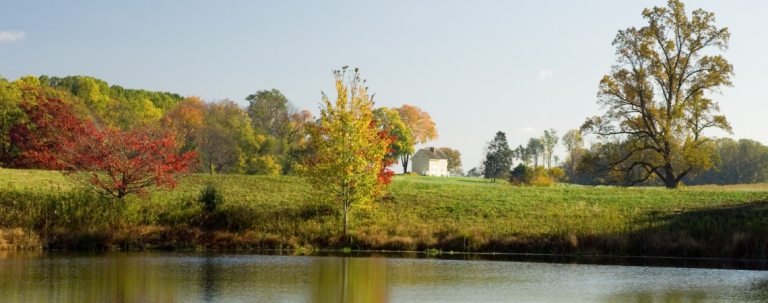Undoubtedly the world’s most valuable resource, water is an integral part of both the Gardens’ beauty and landscape.
Longwood Gardens’ Commitment to Protecting our Water Supply
From the watersheds that tell the story of how water works in our landscapes, to our adoption of advanced technologies for water conservation, we take the stewardship of our natural resources seriously.
Watershed Vitality
A watershed is a community of the land, bound together by the water that courses through it. From rain and melting snow through groundwater, creek and stream, to river, estuary, bay, and ocean, water is the lifeblood of the earth. A watershed includes the network of arteries through which water flows, as well as the land that it nourishes.
On the grounds of Longwood, water runs clean, clear, and cold from springs and lakes before winding its way through tributaries of the Red Clay and Brandywine Creeks. Wide riparian buffers—streamside plantings of native trees and shrubs—work to filter storm runoff to keep the water free of pollutants and excess nutrients. Research by the Stroud Water Research Center recommends buffers of nearly one hundred feet for adequate stream protection.
The roots of streamside trees also prevent bank erosion, keeping the streams wide and clear of sediment. The shade of their canopy keeps the water cool and allows just the right amount of light to filter through to the native algae that thrive in shallow streams. The algae is then grazed upon by insects that form the bulk of the biomass that feeds other invertebrates, fish, and the young of most birds.
Hourglass Lake
Hourglass Lake, originally called Wild Pond, was created as a water supply and for fire protection in 1959. Its placement coincided with a wet, marshy area and stream course, creating a naturalistic water feature. Wetlands are established around the periphery of the lake today and are a thriving habitat within the Meadow Garden. Though originally created through human intervention, the lakes are gradually being reclaimed by nature but are still guided by the human hand.
For more information:
Water Consumption
We employ advanced technologies and proven techniques to reduce our overall water usage while conserving available resources. Among the technologies used to reduce water consumption in the Gardens are timer and drip irrigation systems and UgMO—a novel technology that measures water content in the ground.
When irrigation systems break, they are quickly repaired to minimize the amount of water that is wasted. In times of drought, we adhere to an established drought management program that outlines steps for reducing water consumption.
Re-energizing Our Water Supply
Through an on-site waste water management system, we are able to treat 100 percent of the water from restrooms, restaurants, showers, and tenant homes for irrigation of non-edible plant displays. What isn’t used for irrigation is distributed over a spray field on the property, thereby returning it to the aquifer. The use of native plant communities protects our watersheds by absorbing nutrients and slowing storm water run off.
